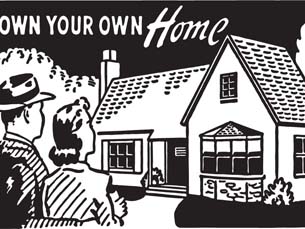Signs
There are two primary types of signs you should consider making. The first are directional signs to help draw people to your home. The second type of sign you should develop is a "For Sale" sign.
When posting directional signs, look for main intersections near to your home. This way, people who are interested in a home in your area are likely to see the signs. Your "For Sale" sign, on the other hand, should be placed on your lawn.
Your "For Sale" sign should include several pieces of information. This includes your phone number, a web address for your Internet posting of the home and the words "By Owner." Make sure the font is large enough that potential buyers can easily read the sign from the street.
When making yard signs, consider having them made at a professional print shop, an office supply store, a drug store or another store that makes professional prints. You can also create your own signs on the web. Simply perform a search of "real estate signs" to find a vendor. A sign that looks like it was made by an amateur or that has a "cheap" look to it will significantly detract from the overall appearance of your home.
Brochures and Flyers
Creating brochures and flyers is another great way to quickly share information about your house. You can quickly and easily make a brochure or flyer with Microsoft Word and other similar programs. Simply perform an Internet search of "real estate flyer template" to find several available options.
When creating brochures and flyers, be sure to include:
- Pictures
- Price
- Information about the property
- Features
- Your contact information
Consider placing a box filled with these brochures or flyers next to your yard sign. This way, interested buyers can stop and pick one up when they drive past your house. Not only does this help make you look more professional, but it also provides the buyer with a quick and easy takeaway reference about your property.
Highlights Sheet
A highlights sheet is another resource that you might want to consider creating, though you may also choose to combine your highlights sheet with your flyer or brochure. A highlights sheet is typically more detailed with and includes information such as:
- Square footage of the home
- Specific room sizes Example:
- Dining Room 10 x 12
- Master Bedroom 12 x 16
- Amenities, such a swimming pool, spa or deck
- Dates of recent improvements
- Features that may not be visible or noticeable without an explanation.
Your highlights sheet should include at least one color photo. These sheets can be easily distributed throughout the community by placing them on community boards in places such as libraries, local shopping centers and grocery stores. Always get permission prior to posting your highlight sheet, brochure or flyer in a public location.
Following the Law
When creating your marketing materials, you need to be aware of laws that regulate the sale of a home. These laws include both State and Federal Fair Housing Laws. Keep in mind that it is illegal to discriminate against a buyer based on that person's race, gender, religion, national origin, family status and other factors. These laws apply to your marketing strategies as well as to your selling practices. To make sure you are not inadvertently violating these laws by mentioning any of these items in your marketing or using wording that could be considered discriminatory. Consult with your real estate attorney if you are unclear.
